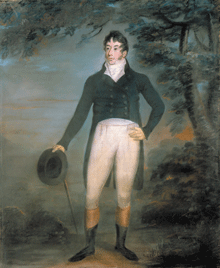Regency Personalities Series-John MacDonald of Garth
Regency Personalities Series
In my attempts to provide us with the details of the Regency, today I continue with one of the many period notables.
John MacDonald of Garth
1771 – 25 January 1866

John MacDonald
MacDonald was born in 1771 at Garth, his family’s estate east of Loch Lomond, near Callander, Perthshire. He was the son of Captain John MacDonald of Garth, of the 8th King’s Regiment, whose grandfather was a son of Alastair MacDonald, 10th Chief of Clan MacDonald of Keppoch. His mother, Magdalen Small, was the daughter of James Small, factor of the forfeited Struan estates in Perthshire. MacDonald’s mother was a niece of Major-General John Small and Alexander Small, two of the first cousins of General John Robertson Reid, 15th Baron Reid. MacDonald himself was a brother of The Hon. Archibald Macdonald. One of his sisters, Helen, married their first cousin General Sir Archibald Campbell, 1st Baronet. His other sister, Magdalen, married The Hon. William McGillivray, of Chateau St. Antoine, Montreal.
MacDonald was small in stature and handicapped since childhood by a withered right arm which led to him being known as Le Bras Croche among his Voyageurs, but prevented him from following family tradition of a military career. Nonetheless, he enjoyed combat. He fought many duels and in Canada always carried on his person a sword and a pair of pistols. On the advice of his mother’s uncle, Major-General Small, MacDonald sailed with Simon McTavish from Scotland to Canada in 1791 to take up employment as a clerk in the North West Company, under the tutelage of Angus Shaw.
Under Shaw, MacDonald was in charge of the building of Fort Edmonton in 1795 and of Rocky Mountain House, Alberta, in 1799. In 1800, he was made a wintering partner of the North West Company and two years later he replaced Shaw at Fort des Prairies, the largest department in the north. In 1803-04, he visited relatives in London where he had his portrait done. In 1805, he established New Chesterfield House and continued to spend his winters in the north until 1808 when he fell ill. Returning to Montreal, he stayed with his sister, Magdalen, and her husband William McGillivray at Chateau St. Antoine, one of the early estates of the Golden Square Mile. That same year he was elected to the Beaver Club, where he ran up a huge entertainment bill.
Returning to the north in the spring of 1809, he shared the charge of the Red River Department and possibly helped to establish Fort Gibraltar. Two years later, he carried supplies to his friend and brother-in-law, the explorer David Thompson, in the Kootenay Ranges.
On the outbreak of the War of 1812, MacDonald went to England to seek permission for an assault by sea to be undertaken by the North West Company on John Jacob Astor’s fur trading station, Fort Astoria. At Portsmouth, he offered a lucrative contract to a young woman, Jane Barnes, to sail with him to the Columbia and become the first white woman on the North Pacific coast.
MacDonald and his men sailed up to the Pacific Ocean via Cape Horn and the Juan Fernández Islands. In 1813, MacDonald and his Nor’Westers successfully attacked Fort Astoria, capturing Astor’s associates from where they took them as prisoners across The Rockies to Fort William. In November, 1813, they purchased Fort Astoria for a nominal sum from the American Fur Company, and at the end of the month, despite having been badly burned in an explosion at sea, MacDonald took charge of the new post. He stayed until the spring of 1814, before leaving for Fort William with a brigade of about 80 Nor’Westers in ten canoes.
MacDonald and his men arrived at Red River while the Hudson’s Bay Company were attempting to prevent the Nor’Westers from living off country provisions, which became known as the Pemmican War. Forced to import supplies from Montreal, the Nor’Westers responded by preparing to destroy the Red River Colony established by Lord Selkirk. MacDonald negotiated a peace, but he was criticized by the NWC partners at the annual meeting and his agreement was disavowed.
In 1799, John MacDonald had married his half-Indian cousin, Nancy Small. She was a daughter of his mother’s cousin, Patrick Small, by his country wife. Her father became a member of the Beaver Club in 1790 before leaving Nancy and her sister for England the following year. Nancy’s sister, Charlotte Small, was married to David Thompson. However, MacDonald deserted Nancy and their home in 1823 to marry Amelia McGillis (d.1830), daughter of Duncan McGillis (1754-1838) and heiress of her uncle Hugh McGillis, another partner in the North West Company. They moved into her uncle’s home at Williamstown, which was the former home of Sir John Johnson, 2nd Baronet. John MacDonald had five children by his first wife and six by his second. His children by both wives included:
Eliza MacDonald. In 1822, she married John Duncan Campbell
Lt.-Col. The Hon. Rolland Macdonald, of Welland County, Ontario.
Antoine Eustache de Bellefeuille MacDonald. He married Marie-Louise de Lotbiniere-Harwood
MacDonald retired in November 1814 and sold his two shares in the North West Company. In 1816, after having devoted over a year to socializing in Montreal, he purchased a small country estate at Gray’s Creek, near Cornwall. There he built a regency villa, which he named after his childhood home, ‘Garth’. When he deserted his first wife in 1823, he set up home with his new wife at Williamstown, Glengarry. He passed ‘Garth’ to his eldest daughter and her husband, John Campbell. The house came to be known as ‘Inverarden’ from the 1870s and remained in the Campbell family until 1965. At Glengarry, MacDonald was active in the local Presbyterian church and served as judge of the Surrogate Court of Glengarry County from 1832 until 1844.





